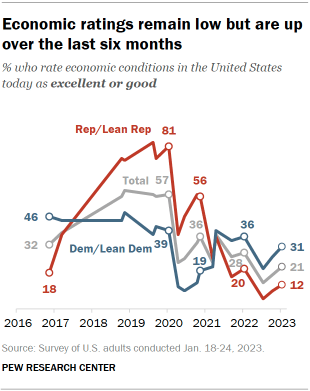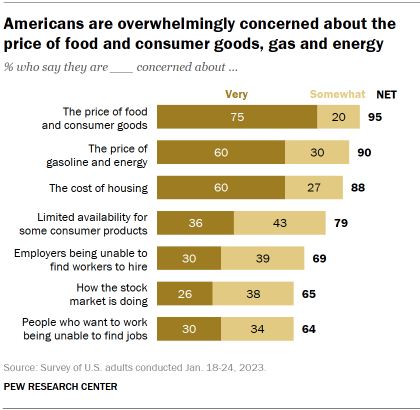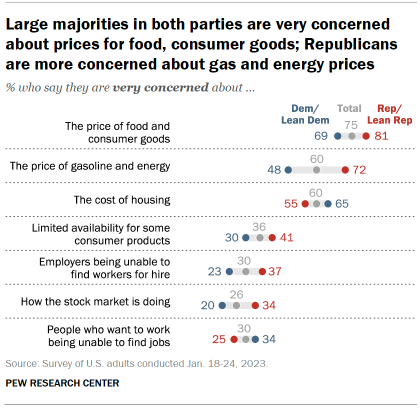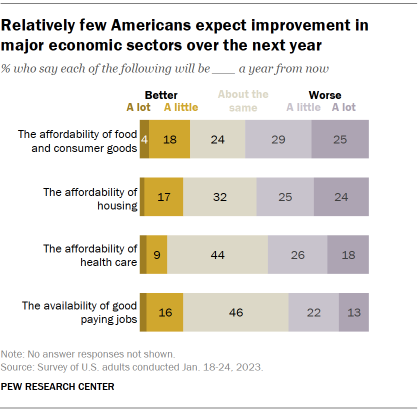
Americans continue to express largely negative views of national economic conditions. Today, about two-in-ten (21%) rate the nation’s economy as excellent or good, up modestly from the 17% who said this in October and the 13% who had positive views of the economy in July. Still, positive ratings remain lower than they were a year ago (when 28% said the economy was in excellent or good shape).
Nearly eight-in-ten (78%) now view economic conditions in the U.S. as either only fair (47%) or poor (32%).
Democrats and Democratic-leaning independents continue to offer more positive assessments of economic conditions than Republicans and Republican leaners: 31% of Democrats say economic conditions are excellent or good, compared with just 12% of Republicans.

The public also remains pessimistic about future economic conditions. Four-in-ten adults (40%) expect economic conditions to worsen over the next year, while about a quarter (23%) say they will improve; 36% say conditions will be about the same as they are today.
Americans’ outlook is slightly more negative than it was this time last year, when 35% expected economic conditions to worsen and 23% expected them to improve.
Republicans are more pessimistic than Democrats about future economic conditions: Over half of Republicans (56%) say economic conditions will worsen over the next year, compared with a quarter of Democrats. Conversely, Democrats are more than twice as likely as Republicans to say conditions will be better a year from now (34% vs. 13%).
Majorities remain very concerned about prices for food, consumer goods, energy and housing

Three-quarters of Americans say they are very concerned about the price of food and consumer goods, while six-in-ten say the same about the price of gasoline and energy and the cost of housing.
Smaller shares express concerns about limited availability of consumer products, employers being unable to find workers, how the stock market is doing, or people who want to work being unable to find jobs.
Americans differ by party in their economic concerns.
About eight-in-ten Republicans and Republican-leaning independents (81%) say they are very concerned about the price of food and consumer goods, while 72% are very concerned about the price of gasoline and energy. This compares with 69% and 48% among Democrats, respectively.

Republicans are also more likely to say they are very concerned about limited availability for some consumer goods (41% vs. 30% among Democrats), employers being unable to find workers for hire (37% vs. 23%), and how the stock market is doing (34% vs. 20%).
By contrast, Democrats are somewhat more likely than Republicans to say they are very concerned about the cost of housing (65% vs. 55%) and people who want to work being unable to find employment (34% vs. 25%).

As was the case in October, there is greater public concern over prices for food and consumer goods, as well as energy and housing prices, than on other economic issues.
However, while the shares expressing concern about the price of food and consumer goods and housing are little changed since October, the share expressing concern over the price of gasoline and energy has dropped from 69% to 60%. Both Republicans and Democrats are less concerned about energy prices than they were in the fall.
Looking ahead, Americans express more pessimism than optimism about prices

Americans are also pessimistic about the future costs of goods, housing and health care.
A narrow majority of adults (54%) say they expect the affordability of food and consumer goods to be a little or a lot worse a year from now, while fewer than a quarter (21%) say it will be a little or a lot better. There are similar views about housing affordability (49% predict it will worsen, 19% say it will improve) and the affordability of health care (44% worse, 11% better).
More Republicans than Democrats predict worsening economic conditions on each of these dimensions over the course of the next year.

Republicans are more likely to say the affordability of food and consumer goods will be a little or a lot worse a year from now, with 67% predicting this compared with 41% of Democrats. About half of Republicans also expect the affordability of health care (52%) and housing (54%) to worsen, while smaller shares of Democrats (36% and 44%, respectively) say the same.
Four-in-ten Republicans (40%) say the availability of good-paying jobs will worsen over the next year, as do 29% of Democrats.


